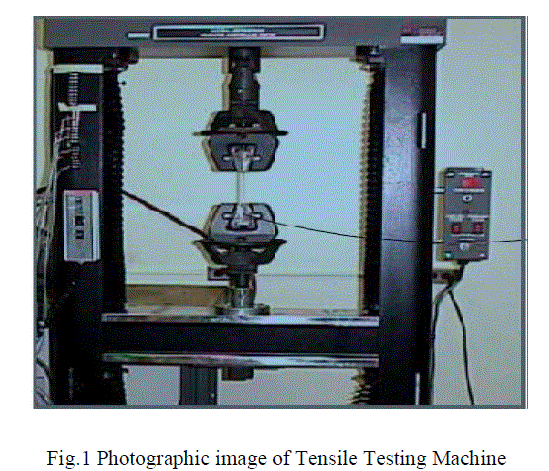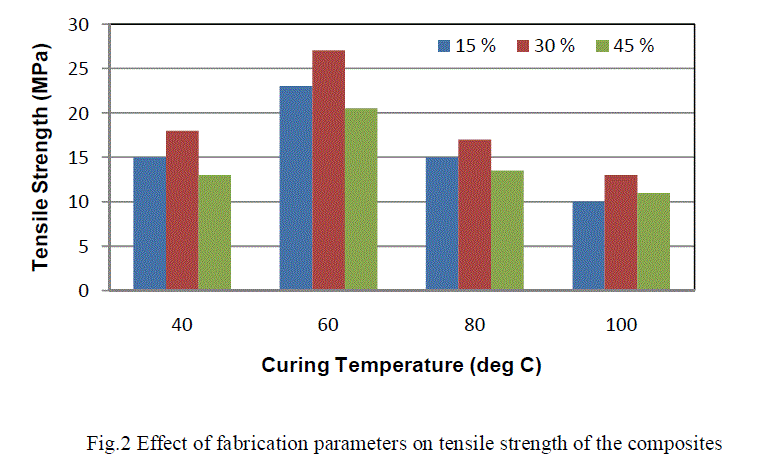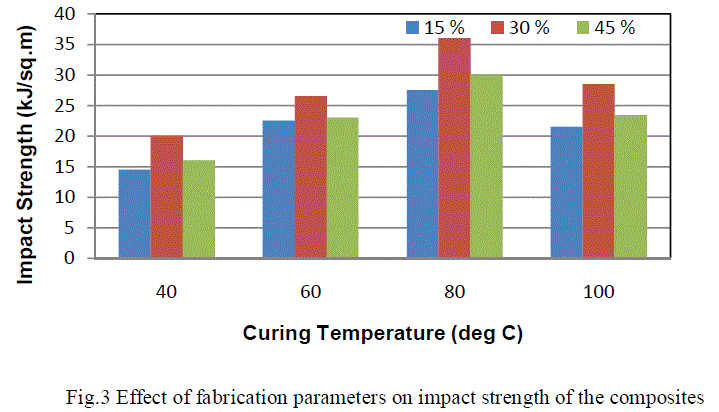ISSN ONLINE(2319-8753)PRINT(2347-6710)
ISSN ONLINE(2319-8753)PRINT(2347-6710)
C.Boopathi*1, S.Kalyana Sundaram2, S.Jayabal3, S.Karthikeyan4
|
| Related article at Pubmed, Scholar Google |
Visit for more related articles at International Journal of Innovative Research in Science, Engineering and Technology
Natural fiber reinforced polymer composites are gaining interest among researchers because of its attractive properties such as low weight, higher stiffness and low cost. This investigation is aimed at studying the effect of curing temperature and fiber volume fraction on the mechanical properties of sisal fiber reinforced polyester composites. The composite sheets were fabricated by varying the curing temperature (40, 60, 80 and 100oC) and fiber volume fraction (15, 30 and 45 %). The fabricated composite sheets were tested for its mechanical properties namely tensile and impact strength as per ASTM standards. The regression model was developed to study the relationship between fabrication parameters and mechanical properties. The tensile and impact properties of sisal fiber reinforced polyester composites were optimized using Response surface methodology (RSM). The result obtained was found to be significant and confirmed the effective role played by fabrication parameters considered in this investigation, on improving the tensile and impact properties of sisal fiber reinforced polyester composites.
Keywords |
| Sisal fiber, Polyester composite, Mechanical properties, Regression analysis, Response surface methodology |
I. INTRODUCTION |
| Due to the development and growth of technology, there is a need for material having high specific properties. This demand cannot be fulfilled by using ceramic and metal alloys. Therefore, natural fiber reinforced polymer composite materials can be used as alternative resources to meet out this demand Moreover there are many advantages in using natural fiber as traditional reinforcing material such as low density, low cost, enhanced energy recovery, acceptable specific strength and biodegradable [1]. For example, flax fiber reinforced polyolefin are widely used today in automotive industry [2]. The mechanical properties of some natural fibers like flax, jute, hemp and sisal, are very good and has been successfully used as reinforcement in polymer matrix composites [3, 4]. A series of investigations have been conducted on different types of natural fibers such as kenaf, hemp, flax, bamboo, and jute to study the effect of fiber on the mechanical properties of composites [5-7].The mechanical properties of natural fiber reinforced composites depend upon various factors such as type of fiber, fiber properties, fiber orientations, fabrication condition. Much research has been carried out in the past to study the influence of these factors on the mechanical properties of natural fiber reinforced polymer composites. The effect of fiber length and fiber content on short banana fiber reinforced polyester composite was studied by Pothan et al. [8]. The tensile strength was observed maximum at 30 mm fiber length while impact strength was observed maximum at 40 mm fiber length. Incorporation of 40% untreated fibers gives 20% increase in the tensile strength and a 34% increase in impact strength. Joseph et al. [9] evaluated the effect of fiber length and fiber content on banana fiber and glass fiber. Belmeres et al. [10] found that sisal, henequen, and palm fiber have similar chemical, physical, and tensile properties. Cazaurang et al. [11] carried out a systematic study on the properties of henequen fiber and reported that these fibers have mechanical properties which are suitable for reinforcing thermoplastic resins. |
| Moreover the fabrication conditions of composites have got a significant role to influence with the mechanical properties of the composites [12]. Modeling and optimization on mechanical properties of polymer composites has opened new platform in Engineering and Commercial applications [13-15].Taking this in to consideration, this work is focuses on studying the effect of curing temperature and fiber volume fraction on the mechanical properties of sisal fiber reinforced polyester composites. The regression model was developed to study the relationship between fabrication parameters and mechanical properties namely tensile and impact strength. The tensile and impact properties of sisal fiber reinforced polyester composites were optimized using Response surface methodology (RSM). |
II. MATERIALS AND METHODS |
| A. Materials |
| The sisal fibers (Tensile strength of 610 MPa and Density of 1.45 g/cm3) collected from local region of Chennai, Tamilnadu was used as a reinforcement materials. The unsaturated polyester resin (Tensile strength of 12.5 MPa and Density of 1.10 g/cm3) supplied by GRV enterprises Madurai was used as the matrix materials. Cobalt Octoate and Methyl Ethyl Ketone Peroxide (MEKP) were used as accelerator and catalyst respectively. Compression molding technique was used for composite fabrication |
| B. Composite Fabrication |
| The sisal fibers were randomly reinforced in a polyester matrix by varying the fiber volume fraction in three levels namely 15%, 30% and 45%. The matrix system comprises of polyester resin mixed with 1.5 % cobalt octoate accelerator and 1.5 % methyl ethyl ketone peroxide (MEKP) catalyst. The composite sheets were fabricated using compression molding method at a pressure of 2.6 MPa, by varying the fabrication temperature in four levels (40, 60, 80 and 100oC).A total of 12 composite sheets were fabricated and cut for tensile and impact strength as per ASTM standards. |
| C. Composite Testing |
| The composite sheets fabricated were tested for its tensile (ASTM D-638) and impact (ASTM D-256) properties as per ASTM standards. The Hounsfield Universal Testing Machine was used for performing the tensile test (Fig.1). The test specimen was positioned vertically in the grips of the testing machine. The testing was carried out at the crosshead speed of 0.5 mm/min. As the specimen elongates the resistance of the specimen increases which was detected by a load cell. An IBM computer connected with tensile testing machine was utilized to record the test data’s. The impact test was carried out using pendulum type Impact tester as per ASTM D 256-10. The test specimen was supported as a simply supported beam and broken by a single swing of a pendulum. |
 |
| D. Modeling and Optimization |
| The tensile and impact properties obtained from experimental investigation were used to develop the regression model between fabrication parameters and mechanical properties. Response surface methodology is the technique used in this investigation to build empirical model between the output response (tensile and impact strength) and independent variables (curing temperature and fiber volume fraction). The mathematical model developed was justified based on 3D response surface plot and coefficient of correlation resulted from statistical software (Design Expert V 8).The model thus developed was optimized to maximize the tensile and impact properties of sisal fiber reinforced polyester composites. |
III. RESULTS AND DISCUSSION |
| A. Tensile Strength of the Composites |
| The effect of curing temperature and fiber volume fraction on the tensile strength of the composites is shown in the Fig.2.The tensile strength of the composite experienced a gradual increase in its strength with the rise in curing temperature, however the value reached a maximum of 27.5 MPa at 600 C and tends to fall when the temperature is increased beyond 600 C. This is due to the better wet ability of sisal fibers with the polyester matrix. Similarly composites fabricated with low fiber volume fraction (15 %) experienced poor tensile properties which is due to poor stress transfer between fibers and matrix. The poor tensile properties of composites fabricated with higher fiber volume fraction (45 %) is due to the incompatibility of larger volume of fibers in smaller matrix proportion. |
 |
| B. Impact Strength of the Composites |
| The influence of curing temperature and fiber volume fraction on the impact strength of the composites is shown in the Fig.3.The impact strength (36 kJ/m3) of the sisal fiber reinforced polyester composites was found to be better with the composites fabricated at 30 % fiber volume fraction. The curing temperature of the composites was also found to play a significant role in improving the impact properties of the composites. The composite sheets gained its impact strength when the curing temperature was increased gradually and reached its maximum at 800 C. The composite sheets fabricated at 800 C ensured uniform spread of resin throughout the sheets which in turn improved the bindability of fibers with matrix. But increase in temperature beyond 800 C resulted in poor impact properties. The higher squeezing of resin form the mould subjected to compression witnessed loss in resin viscosity at higher temperature. This rooted to poor sticking of resin over the fiber surface which ultimately leads to poor impact strength |
 |
| C Empirical Model Using RSM |
| The regression model for tensile and impact strength of sisal fiber reinforced polyester composites was developed using Response surface Methodology (RSM). The 3D response plot for tensile and impact strength obtained from statistical tool are shown in the Fig.4 (a) and Fig.4 (b) respectively. The plot indicated the interaction effect of curing temperature and fiber volume fraction on the tensile and impact strength of the sisal fiber reinforced polyester composites. The coefficient of correlation (R2) obtained for tensile and impact strength of the composite was 0.92 and 0.93 respectively. The higher value of R2 (close to 1) indicated the significance of model developed using Response surface methodology. |
 |
| The tensile and impact strength of the composite exhibited a quadratic relationship with the fabrication parameters namely curing temperature and fiber volume fraction as given in equation (1) and (2). |
 |
| Where ts is the tensile strength (MPa) of the composites and is is the Impact strength (kJ/m2) of the composites, tc and vf are Curing Temperature (deg C ) and Fiber Volume fraction (%) respectively. |
| D. Optimization Using RSM |
| The mathematical model developed was optimized for identifying better value of tensile and impact strength. The fabrication condition (curing temperature and fiber volume fraction) which may yield better tensile and impact strength was predicted using Response Surface Methodology. The prediction plot for tensile and impact strength of the sisal fiber reinforced polyester composites are shown in the Fig.5 (a) and Fig.5 (b) respectively. The better value of tensile strength of 27.86 MPa was predicted at curing temperature of 61.5 o C and at a fiber volume fraction of 28.14 %. Similarly better value of impact strength of 35.06 kJ/sq.m was predicted at a curing temperature of 79 o C and at a fiber volume fraction of 31.35 |
 |
IV CONCLUSION |
| The curing temperature and fiber volume fraction considered in this investigation has greatly affected the mechanical properties of sisal fiber reinforced polyester composites. The prediction model developed using RSM was also found to be significant. The Response surface optimization used in this investigation has effectively predicted the mechanical properties of sisal fiber reinforced polyester composites. The curing temperature of 61.5 oC & 79 oC can be considered as promising condition to attain better tensile and impact properties respectively. Similarly fiber volume fraction ranging between 28 to 30% can be considered as promising condition to attain better tensile and impact properties respectively. This specific investigation will open up a new platform for natural fiber reinforced composites. |
References |
|